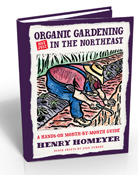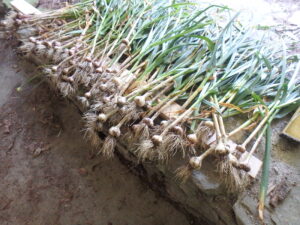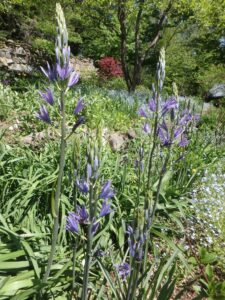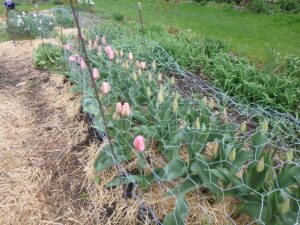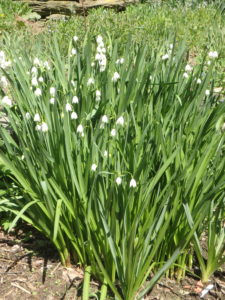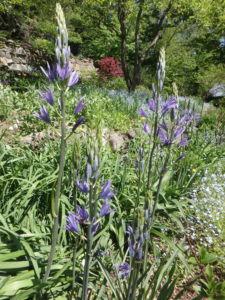Planting in October
For some of us, planting time is long past – but not for me. I am always busy in the fall, planting everything I can. It is almost time to plant garlic, which is my easiest crop of all. And I’ll soon be planting spring bulbs, both in the ground and in pots for forcing. Now is the time to purchase bulbs and seed garlic if you don’t have any garlic of your own to plant.
Garlic is by far my least labor-intensive vegetable crop. I start by weeding out one of my wide, mounded beds and loosening the soil well. I use my CobraHead Weeder to loosen the soil and to make shallow furrows 8 to 12 inches apart. I sprinkle some granular organic fertilizer in the furrow, and run my hand tool through the soil again to work in the fertilizer.
Each garlic bulb has 4 to 8 cloves, which need to be separated for planting. Plant them 3- to 4-inches apart and about 3-inches deep. Cover and press down the soil over them, watering if the soil is dry. Lastly mulch with a thick layer of straw or mulch hay. I use 8 to 12 inches of loose straw which gets packed down to 4 inches by the winter snows. Garlic will grow up through the mulch, but most weeds will not.
To learn more about garlic, you might want to read “The Garlic Companion: Recipes, Crafts, Preservation Techniques and Simple Ways to Grow Your Own” by Kristin Graves. (Storey Publishing, 2024). A nice book, it taught me few things and has recipes I will try. Kristin is a Canadian farmer who grows 75,000 bulbs of garlic each year, so she knows her stuff!
I also plant a lot of spring-blooming bulb flowers in pots for early blossoms indoors and as gifts to friends. I mix used planting mix from summer pots with good compost and plant daffodils and tulips in planters and my window box. You can pack the bulbs close together in pots – and they need only a couple of inches of soil mix above and below them. Store them in a cool, dark place – 35 to 50 degrees is best. But even a cold garage will work if they can establish roots early and then snooze a little if the soil freezes.
Daffodils take about 12 weeks of dormancy before they should be brought into the warmth of the house, but tulips do better with 16 weeks. Little things like crocus can be forced in 8 to 10 weeks. Be sure to label them with the date planted and variety. Water lightly once a month. My favorites are Tête-à-Tête daffodils – small early daffodils in bright yellow. I pack 4 bulbs into a 4-inch pot and share them in February and March when friends need a pick-me-up.
This is also the time to plant bulbs outdoors for spring. Most bulbs like a sunny location with well-drained soil, but you can also plant bulbs under deciduous trees if they get enough sun filtered through them, or before they leaf out. If you have a site with good sun but moist soil, there a few bulbs that will work. “Thalia” is a white blossomed, late-blooming daffodil that does well even in fairly wet soil.
Camassia is a bulb plant that prefers damp soil. It produces blue to purple flowers on tall stems – up to 3 feet tall with hundreds of small blossoms. A good sandy loam is best, but it will do fine in any sunny soil that stays moist during the bloom season. It is not of interest to deer, and will keep coming back for years if happy where you plant it.
Tulips, on the other hand are delicious to deer as flowers, and to rodents as bulbs. During World War II some Dutch bulb growers avoided starvation by eating their tulip bulbs, though I have never been that hungry! To foil the deer I plant 100 tulips in my vegetable garden most years and surround and cover the bed with chicken wire. I grow them as annuals, pulling the bulbs after they bloom.
Planting 100 bulbs of the same kind means they all bloom at about the same time. So I cut them and put flowers in quart jars and deliver to friends, neighbors, the elderly and the infirm. It is so much fun to do so! Try it.
Over the years I have planted hundreds, nay, thousands of daffodil bulbs. Most survive and thrive – nothing eats them. I have a patch of daffies from bulbs I dug up at my boyhood home in the early 1970’s – some 50 years ago. To keep them producing well it’s good to top-dress the soil with ‘”bulb booster” or a good slow-release organic fertilizer- either now, or in the spring.
To plant 25 daffodils I dig a hole about 6 inches deep, a couple of feet long and about 18-inches across. I loosen up the soil in the bottom with my CobraHead Weeder, a single-tine cultivator. I sprinkle a cup or so of organic fertilizer in the bottom, and work it in, working in a bucket of compost, too. Then I plant the bulbs, pointy end up. The directions may tell you to plant daffodils 6-inches apart, but I tend to plant them 3- or 4-inches apart and they do fine. I press them down into the loose soil.
Lastly, I refill the hole. If the soil is full of rocks, I remove them. If it is sandy or full of clay, I mix the soil I use to refill the hole with a 50-50 mix of good compost and soil.
So take a sunny afternoon and go plant bulbs – either outdoors, or in pots for forcing. It’ll be something to look forward to all winter.
Henry is writing just one article per month. You can reach him at henry.homeyer@comcast.net
It’s Time to Plant Bulbs for Spring Blossoms
This is the season for planting bulbs – from mid-October until the snow flies. Actually, I’ve shoveled snow off a bed to plant bulbs in November, and they did fine. Bulbs have everything inside them needed to succeed their first year. If you want them to keep on thriving, they will generally need plenty of sunshine, good drainage – and you must not cut off the foliage before it starts to die back.
That said, there are exceptions. The small bulbs like snowdrops, crocus, scilla and glory of the snow are fine in the shade of deciduous trees. That’s because they will bloom early and re-charge themselves before the trees get dressed in leaves that will shade their beds. No bulbs that I know of thrive in the shade of pines, hemlocks or other conifers.
Deer can be a problem for some sorts of bulbs. Tulips are tasty to them, and many a gardener has wept tears of frustration when the deer ate their tulip buds the night before they were to open. Repellents can work – my aging corgi, Daphne, is still a great deterrent – but there are commercial repellents as well.
Garlic, soap, coyote urine and nasty repellents made with rotten eggs and blood meal can keep deer away – unless they are really hungry, or just plain mean. If deer are a problem, you can protect bulbs with wire mesh. No need to build an 8-foot fence, just build a dome or cage over them using chicken wire.
Squirrels, mice, voles and chipmunks can eat bulbs. Some folks buy cheapo hot pepper powder to sprinkle in the bulbs, but it is probably only good for one season. You can put sharp cinders or oyster shell meal (sold at feed and grain stores for chickens) into the hole at planting time. Alternatively you can feed the rodents all winter, or catch and deport them in a Hav-a-Hart trap. Peanut butter with a sprinkling of sunflower seeds will attract them to your cage. They can’t resist.
In the past I have always planted 25 to 50 bulbs in a hole at once. I dig to the appropriate depth, loosen the soil at the base, add some fertilizer and scratch it in. Usually I just use a slow-release organic fertilizer like Pro-Gro, but there are mixes made specifically for bulbs, often called Bulb Booster. I place the bulbs in the hole, pointy end up, and fairly close together. I plant bulbs closer than the directions say – and no bulb has ever complained.
I recently attended a presentation on bulbs by a Dutch expert, Jacqueline van der Kloet. She proposed random plantings. She showed slides of wheelbarrows filled with bulbs of various types, sizes and bloom dates. She mixed them together and then tossed them out onto a flower bed for planting. Her people used trowels to plant every bulb individually. That seems like a lot more work, but the look in spring was interesting.
On a recent Sunday I gave random planting a try. We had 25 daffodils, 150 crocus of various types and 6 big alliums. The bed for the bulbs was about 2 feet wide and 10 feet long. The soil is very rich and fluffy, so planting was easy. Even with a fruit tree and 4 peonies in the bed there was room for the bulbs. We will plant annuals in that bed, come June, so we may inadvertently disturb some of the bulbs when we do that.
Instead of using a trowel to plant, I pulled back the soil with a curved hand tool with a single-tine called the CobraHead weeder. For crocus, planting was easy: they only need to be 3 inches deep. To get down 6 inches for the daffodils and allium, I needed to use my fingers to keep the loose soil from falling into the planting hole as I prepared it. Still, it went along quite quickly.
Most bulbs don’t like soil that is constantly wet. Much of my property is on the flood plain of a little stream, and in winter and spring does stay quite moist. In the past I have had good luck in the moist areas with Camassia (Camassia sp.), Summer Snowflake (Leucojum aestivum) and some daffodils. I have done tulips there, too, but in raised beds to improve drainage.
Camassia is a lesser known flower, generally in shades of blue or white. The stems are about 18 inches tall, with many florets along the top part of it. They bloom in May or June and hold up well on the stem and in a vase.
Summer snowflake has tall white flowers that resemble snowdrops on steroids: they are on stems that are 12 to 18 inches tall, and each stem has 3 or 4 flowers. I got 25 bulbs about 20 years ago, and now have a huge clump each spring. They bloom in mid-May for me.
Ms. van der Kloet recommended two varieties of daffodils that do well in damp soil: Jenny and Thalia. Thalia I have grown: it’s a nice white one, and fragrant. My recommendation for gardeners with moist soil? Add lots of compost to the soil, including under the bulbs, and raise the beds as much as possible. Even 4 to 6 inches will help. But if you have truly soggy soil, your bulbs may rot, so experiment before planting in large numbers.
Winter is long, and I want something to look forward to. Spring bulbs are worth every penny I spend on them. And if a few get eaten by rodents or succumb to soggy soils? So be it. I will always have plenty to enjoy.
Henry Homeyer is a gardening coach, speaker, and consultant and is the author of 4 gardening books. He can be reached at henry.homeyer@comcast.net.

